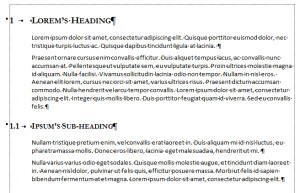Evolution and the Infinite Number of Monkeys Theory
When word processing programs like Microsoft Word came along, it made typing pools all-but obsolete and placed the creation of documents literally at the fingertips of document authors.
True story – I wrote a script for a pantomime in the 1980s and typed it into a programming language source code editor so I could get a printed version. It wasn’t case-sensitive, so everything was in upper case, in a monospace typeface. (It also had a bazillion program compile errors!) The scripts were printed out on 15in x 11in green bar continuous stationery complete with sprocket holes.
No longer did people have to dictate, read and correct – they could type, print, sign and envelop their own letters, and trot them down to the mail room. Technical types such as programmers and engineers could produce documentation without suffering the perceived indignity of sitting in front of a typewriter or begging the boss’s overworked secretary to type it up for them. (Do you detect “personal experience” in that last sentence?)
Typing skills became a major requirement for just about everyone. Suddenly, people had to learn really quickly how to create a good(-enough)-looking letter or technical guide.
It was all supposed to be so intuitive that many people didn’t need training, and those who did were likely intimidated so much by those who didn’t that they didn’t bother. So they did what worked. Typewriters, Telexes, and “dumb” computer terminals all formatted text via tabs and line feeds – why reinvent the wheel – so they hit the “Enter” and “Tab” keys.
For many people and many documents, that seemed to work well.
But it seemed to spur them on to feeling able to create bigger and more complex documents using their new-found typing and formatting skills. This was all very well, just so long as the document didn’t need to be updated. Sure – it might be a little bit of a fight to get those graphics to stay in the right place, but eventually…
It seemed like the world was trying to test out an updated form of the infinite number of monkeys theory – get enough do-it-yourself document writers working on enough computers, and eventually one of them will figure out the intended formatting techniques.
What Would Cheeta Have Thought of Word?
(Okay – so Tarzan’s companion was a chimpanzee, not a monkey. Fire me.)
The thing is that Word is much more sophisticated than a typewriter or a dumb computer terminal. Most of the terminology comes from the printing trade (“font” and “typeface” somehow got intermingled though) and it’s capable of emulating the kind of things that old-time printers (people, not machines) could do with page layout.
And more – it’s capable of saving the various aspects of the layout as “styles”.
Word has some built-in styles. If you’re happy with the way they look, then you can use them and you don’t have to worry about controlling them.
Unfortunately, customizing some styles is less-than-straightforward. In fact, it can be so downright frustrating that a person might give up and go back to the “dumb terminal” techniques.
In order to learn to control these problematic styles (multilevel headings and multilevel lists are the biggest pains), I spent time searching the interweb, and discovered a number of respected technical writers who recommend using the built-in styles whenever possible. The late Shauna Kelly (whose website is being kept online by Lene Fredborg) was one such advocate. I have the relevant pages of her website bookmarked, and refer to them whenever I want to change the layout of headings or lists – I don’t do it often enough to remember how.
The great thing about styles is that when you want to change the layout or look of a document, you can achieve it easily, by changing the style definitions.
Let’s say that you build a draft of a document and decide that your sub-headings need to be slightly larger, italicized, dark blue, and preceded by half an inch of whitespace. If you didn’t use styles, you’d have to change each one individually. If you did use styles, you could modify the style definition for that sub-heading, and boom!
Likewise, if you have a ten-year-old document whose layout is looking a little dated, you can either do a re-format of each heading and paragraph (etc.), or you can modify the style definitions. The point is that you can only change documents using style definitions if the document was created using those style definitions. If everything was written using the “Normal” style (and maybe “Heading 1”, “Heading 2” and “Heading 3” for headings), the facelift might take a lot longer.
There are many other benefits of using styles properly – multi-level headings that number and re-number correctly; nested lists that format and number themselves correctly and consistently; font changes; automatic starting of a new page before a heading; consistent indentations; the list goes on.
One of the many benefits of hiring a professional technical writer is that he or she will format your documents using styles. If your organization has a house style, he or she will use that.
How to Tell How Whitespace Was Created
In MS Word, the quickest and easiest way to discover how a document has been laid out is to turn on the hidden formatting symbols and then see what symbols show up.
Let’s assume you have a document with the following content.
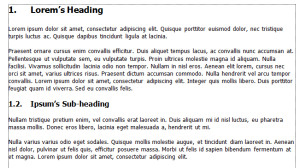
To show the hidden formatting symbols, do the following. (Instructions are for Word 2010)
- In the ribbon, click the “Home” tab.
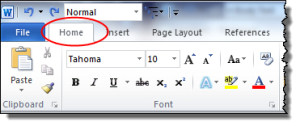
- In the “Paragraph” section, check to see if the “¶” button is visible.
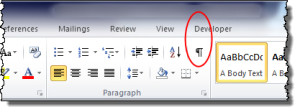
- If it is, click it.
- If it isn’t, then press CTRL + SHIFT + 8. (This is the shortcut key for the same thing.)
Your document should now be displaying all its hidden symbols.
If your document looks like the one below, with “¶” symbols on their own lines, then it’s been formatted using typewriter techniques. The circled symbols show where the writer hit “Enter” to create whitepsace.
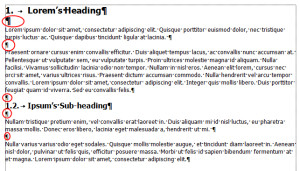
Although I don’t show it here, this document was created using the “Normal” style exclusively. The level 1 heading was created by increasing the font size, bolding it, then adding “1.” followed by a tab character. The level 2 heading was created the same way.
If I wanted to change the text (but not the headings) to another font (Tahoma is not my favourite by a long way), I would have to change each paragraph individually.
If I’d used a different font to highlight a word (a filename perhaps) by using a different font, I’d have to be careful not to lose that different font.
If I wanted to insert a new sub-heading before the current section 1.2, I’d have to re-number the current section 1.2 manually.
Here is the same document with formatting achieved using styles.
Headings are now formatted using the “Heading 1” and “Heading 2” styles. Text is a “Body Text” style. Whitespace is specified within each of the styles and will therefore remain consistent. If I want to change the look of the headings, I change the underlying style and it would get changed throughout the document wherever that style is used.
Who Cares?
None of this matters for a write-once-and-throw-away document. It doesn’t matter much for informal documents or documents that only you will use.
It does matter when you’re creating a library of documentation for your organization that will require periodic review and update, and which will need to look consistent with your organization’s branding or style. Then it matters a lot – no matter how long or complex the document is, it needs to be formatted using styles, by someone who knows what they’re doing.
Shakespeare’s Method Is More Efficient
Of course, an infinite number of monkeys would eventually get the document formatted properly using styles, just as they would eventually write the complete works of Shakespeare. However, the approach does have its drawbacks.
Getting the Job Done Properly
A much better approach is to hire a Technical Writer. Apart from avoiding the space, time, feeding and cleaning challenges of so many primates, the Technical Writer can also ensure that your material is clear, concise, unambiguous, logically sequenced, and written appropriately for its intended audiences.
Technical Writers who are worth their salt are also good interviewers, organizers and synthesizers. Many (most?) (all?) are also pedants who might drive “big picture” thinkers absolutely crazy with their clarifying questions. Think of this as a “necessary evil” aspect of the writer’s work, in much the same way as a doctor’s digit is during a full physical examination.
Word processing software revolutionized documentation – it made it easy possible to produce results that previously required the skills of a printing house. This revolution triggered an exponential rise in the amount of documentation being produced. And with that came the need to organize and maintain that documentation, as well as a desire to make it look consistent and in keeping with the organization’s standards.
If you can’t train your in-house folk to structure your documentation professionally, hire in your own Shakespeare.
